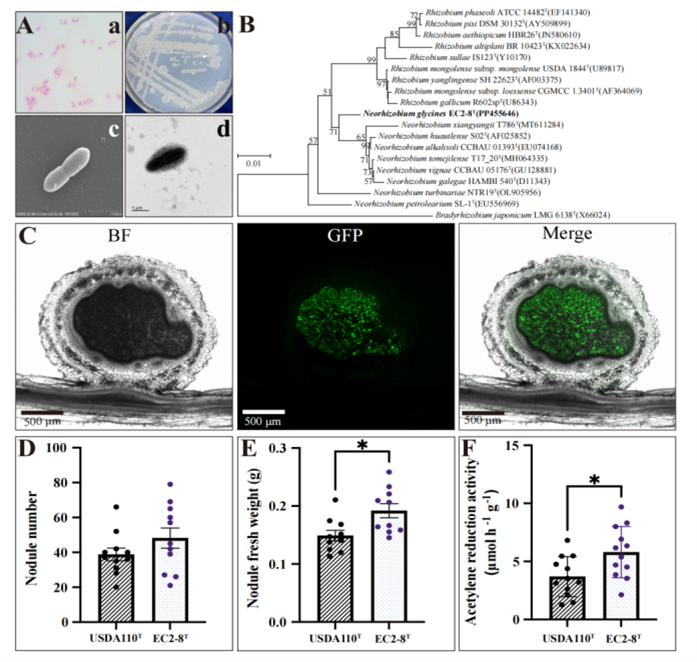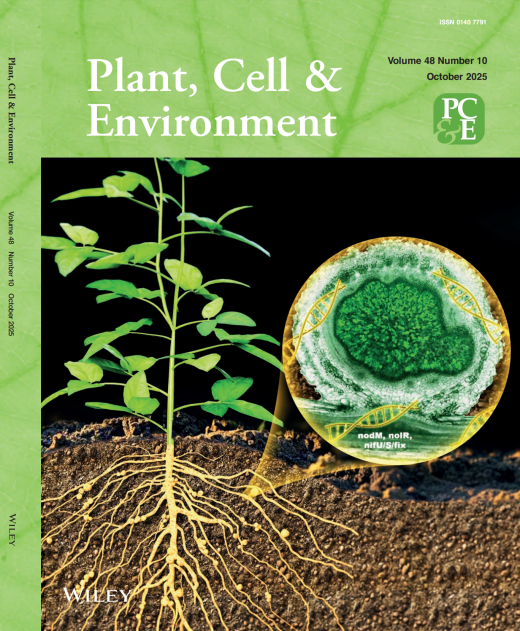As typical nitrogen-fixing bacteria, rhizobia possess the ability to induce the formation of nodules on the roots or stems of leguminous plants and reduce nitrogen gas to ammonia within these nodules. The symbiotic relationship formed between rhizobia and leguminous plants constitutes the most efficient biological nitrogen-fixing system on earth, having profound implications for sustainable agricultural development and the global nitrogen cycle. To date, it is known that rhizobia are primarily distributed among the α, β, and γ-Proteobacteria classes, encompassing 3 orders, 9 families, and 21 genera, such as the commonly known Bradyrhizobium and Rhizobium. Among these, the genus Neorhizobium belongs to the family Rhizobiaceae, with 8 valid species currently described, but there have been no reports of this genus being isolated from soybeans.
Recently, a researcher Assoc. Prof. YU Zhenhua from the Northeast Institute of Geography and Agroecology, Chinese Academy of Sciences revealed a new species of Neorhizobium glycines sp. nov., with a promising soybean symbiont.
This work was published in Plant,Cell & Environment on 9 Sep 2025.
Researchers have successfully isolated and identified a novel species of the genus Neorhizobium from soybean root nodules. The study revealed that the 16S rRNA gene sequence similarity between this strain and known Neorhizobium strains ranges from 98.14% to 98.57%, slightly below the threshold of 98.65% for new species identification. Additionally, the whole-genome average nucleotide identity (ANI) and digital DNA-DNA hybridization (dDDH) values were 70.3%-88.7% and 18.4%-36.7%, respectively, both below the criteria for new species designation. Combined with phenotypic characteristics and cellular chemical composition analysis, the biological traits of this strain were further validated, confirming it as a new species within the genus Neorhizobium, named Neorhizobium glycines EC2-8T. By constructing a fluorescently labeled strain, researchers found that EC2-8T successfully infected soybean root nodules and significantly promoted nodulation (Figure 1). Compared to the commercially mature and high-performing rhizobium strain USDA 110T, EC2-8T demonstrated significant advantages in nodule number, fresh weight, and nitrogenase activity, highlighting its potential for future agricultural applications.
Currently, this strain has been deposited as the type strain of the genus in the microbial culture collections of China and South Korea. This study provides a valuable addition to the international rhizobium strain resource library, facilitating free access to strain resources for global researchers to study the biological characteristics and nitrogen fixation mechanisms of different rhizobia, thereby advancing global rhizobium research. The findings were featured as the cover article in the journal of Plant Cell & Environment (Figure 2).
The research was supported by the National Key R&D Program of China (2021YFD1500400), the Strategic Priority Research Program of the Chinese Academy of Sciences (XDA28020201), and the National Natural Science Foundation of China (32172123, 42207399).

Figure 1 (A) Phenotypic characteristics of strain EC2‐8T on yeast mannitol agar (YMA) medium. (a) Gram staining. (b) Colonies on YMA solid medium. (c) Scanning electron microscopy. (d) Transmission electron microscopy. (B) Neighbour‐joining phylogenetic tree was constructed based on 16S rRNA gene sequences from strain EC2‐8T and closely related reference strains. (C) Soybean nodules infected with the fluorescently tagged strain EC2‐8T. Images taken 14 days after inoculation. Scale bars: 500 μm. BF, bright‐field image; GFP, green fluorescent protein‐labelled strain image; Merge, merged GFP and bright‐field images. (D–F) Comparison of growth indices of soybean inoculated with strain EC2‐8T and USDA110T. Nodule number (D), nodule fresh weight (E), and acetylene reduction activity (F). * indicates significance at p < 0.05.

Figure 2 Cover image of Plant, Cell & Environment (Oct, 2025)
Key words: Neorhizobium, Nitrogen fixation, Soybean, Comparative genomics, Genomic plasticity
Contact:
Assoc. Prof. YU Zhenhua,
Northeast Institute of Geography and Agroecology, Chinese Academy of Sciences, Harbin 150081, China
Email: yuzhenhua@iga.ac.cn
Reference:
Yong Long, Yansheng Li, Jing Zhang, Jiaxuan Liu, Qingqing Han, Yingxue Cao, Yijia Jiang, Changkai Liu, Yanfeng Hu, Guanghua Wang, Xueyan Zhang, Jian Jin, Mikhail Semenov, Guanran Han, Xiaobing Liu, Zhenhua Yu*. Unconventional nitrogen fixation and adaptive genomics of a new Neorhizobium glycines sp. nov., a promising soybean symbiont. Plant,Cell & Environment. 2025,48,7422–7425.
https://doi.org/10.1111/pce.70046

